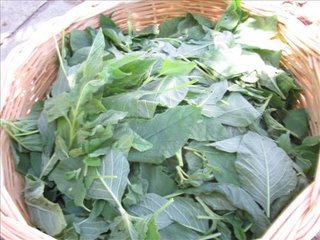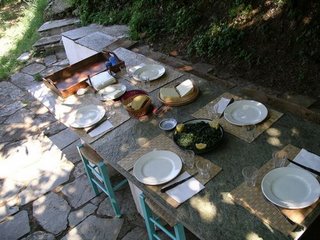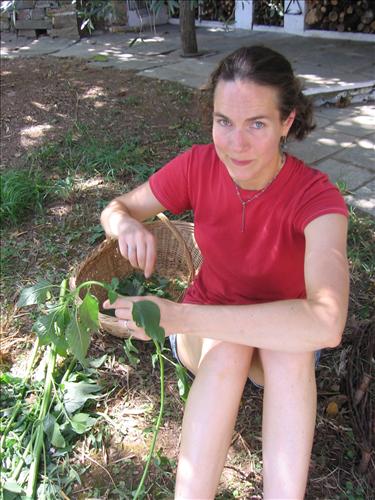La Festa al Fresco - Wilted Vlita with Feta Cheese
Ivonne of Cream Puffs in Venice has asked me to bring a fresh ingredient dish to her festa al fresco. Just coming back from vacation in Greece where we lunched and dined al fresco daily, I had a lot of ideas to choose from. This simple warm salad, though is singularly tasty, simple and fresh.
 In Greece, even the weeds are delicious! Vlita is one of many edible “volunteer” plants that pop up everywhere in Greece. If you know your stuff, you can eat different varieties of “organic field greens” (a.k.a. weeds) all year round. You can find numerous dandelion-like varieties in the spring but Vlita is the one that grows most abundantly in summer and I’ll be darned if it doesn’t taste just like spinach - without the bolting in high heat!
In Greece, even the weeds are delicious! Vlita is one of many edible “volunteer” plants that pop up everywhere in Greece. If you know your stuff, you can eat different varieties of “organic field greens” (a.k.a. weeds) all year round. You can find numerous dandelion-like varieties in the spring but Vlita is the one that grows most abundantly in summer and I’ll be darned if it doesn’t taste just like spinach - without the bolting in high heat!  These days, though it’s mainly the older folks in the countryside who still pick the greens by hand as it’s not the most fashionable thing anymore. “Progress,” you know. You can still, however, buy the greens someone else has picked in open-air markets. Out at the summer house, vlita shoots up in any vacant square inch of the vegetable garden and none of us do anything to stop it. Music to grow vlita by: REM's 1982 "hit" (well, at that time they didn't really have hits, now did they?) "Gardening at Night" Michael Stipe was famous for mumbling his lyrics and when fans would try to copy them down, send them to him and ask, "Are these the words to X song?" he would invariably answer, "Yes" no matter what they had written. Once the vlita threatens to overtake the tomatoes and eggplants, we yank it out by the barrelful and strip the smaller, more succulent leaves to make “hortopita” (greens pie, just like “spanakopita” is spinach pie) see recipe here, or simply this delicious warm salad of wilted vlita with feta cheese sliced on top.
These days, though it’s mainly the older folks in the countryside who still pick the greens by hand as it’s not the most fashionable thing anymore. “Progress,” you know. You can still, however, buy the greens someone else has picked in open-air markets. Out at the summer house, vlita shoots up in any vacant square inch of the vegetable garden and none of us do anything to stop it. Music to grow vlita by: REM's 1982 "hit" (well, at that time they didn't really have hits, now did they?) "Gardening at Night" Michael Stipe was famous for mumbling his lyrics and when fans would try to copy them down, send them to him and ask, "Are these the words to X song?" he would invariably answer, "Yes" no matter what they had written. Once the vlita threatens to overtake the tomatoes and eggplants, we yank it out by the barrelful and strip the smaller, more succulent leaves to make “hortopita” (greens pie, just like “spanakopita” is spinach pie) see recipe here, or simply this delicious warm salad of wilted vlita with feta cheese sliced on top. 1 kilo (2.2 pounds) vlita or other organic field greens (sturdy ones for cooking)
1 tbsp olive oil
salt and pepper to taste
*150 grams (about 5 ozs) feta cheese
Wash the leaves thoroughly in cold water and drain. In a very large stock pot, heat the oil over medium. Begin to add the greens with some of their water still clinging to the leaves and stir. Continue to add handfuls as the greens in the pot begin to wilt and the overall volume decreases. Keep stirring and flipping the bottom wilted leaves over the raw leaves. Once all the leaves are in the pot add salt and pepper to taste. Cook until everything is tender (this takes longer for vlita than for spinach). Take off heat and arrange in a wide, shallow bowl. Allow to cool a bit then *sprinkle or slice feta cheese on top. Serve as a side dish to meat along with some crusty bread. Any leftovers can be used as filling for hortopita.
 *Note: another delicious variation (seen here if you look hard enough) is to omit the cheese and drizzle some extra virgin olive oil on top along with a generous squeeze of lemon.
*Note: another delicious variation (seen here if you look hard enough) is to omit the cheese and drizzle some extra virgin olive oil on top along with a generous squeeze of lemon.


9 Comments:
What an incredibly interesting post, Susan! I'd never heard of vlita. It makes me think of dandelion greens which people would grow in abundance but now some turn their nose up at it (but they'll pay ridiculous prices for it in a gourmet shop). Go figure!
Anyway, this simple salad seems like the perfect way to celebrate la festa al fresco.
Thank you so much!
Let's hear it for vlita! And all the great horta dishes.
I've been meaning to send you this, Susan, since remembering your foodie-anti-foodie post a few months ago.
http://www.popmatters.com/features/060815-foodporn.shtml
Enjoy,
Suz Haniote
I, too, have never heard of this green.. but is sounds delicious!
Thank you for joining the party, Susan!
Fashionable food or not, vlita sounds like soul food to me! Very interesting post on something that I've never heard of before and reading it...just delicious! As for your previous post on the blackberry hunt, simply loved it. My god, I'm envious of the amount that you all collected!
RYN: If you do visit The Cheese Stands Alone next time home, please fill in on the details! I hope they're still up and running. If only I could find such a place in Hawaii...
Hi Ivonne, Thanks for the invitation! Vlita is the summer version of dandelions which are usually picked in late winter and spring, but vlita tastes more like spinack without any bitterness. Actually I just found out it's also an Italian weed! We saw some on an Alpine hike just yesterday!
Hi Suz, I'm so glad you know about horta! Checked out the article you posted. Some pretty compelling stuff. I'm glad to be reminded that food snobbery is empty and meritless (well, actually just like other forms of snobbery!) Thanks.
Hi Lis, If you ever get a chance to try them, or pick them for that matter don't turn it down!
Hi Rowena, Thanks! Oh, but talking about envy, I remember the wildest "cherries" you had in Hawaii, the ones that looked like fancy, red Chinese lanterns. The cool thing is that we're all here together to educate each other. Will post on The Cheese Stands Alone if I get the chance.
Hi Susan,
I hail from South Australia, but still I do not know what vlita looks like as it grows. I have Greek friends and one tells you that it looks look’s totally different from another friends vlita, how does it grow and what does it look like as a plant form?
Here in South Australia dandelion grows abundantly as doe’s vlita all year round that is if I know which variety is the proper one? Is vlita good for lowering blood sugar levels in Diabetics, as I am one?
Ozimalethatsme
This comment has been removed by a blog administrator.
It's great that you discovered and enjoyed Vlita, I'm posting about today.
Hi there,
we just spent our holidays in the Pilion-area (for the third time) and again cooked vlita, but it's hard to get even in Greece. I would love to get it here in Germany. I heard that it is botanically a sort of amaranth. Does anybody know a botanic name for it? Maybe it would make asking for it easier...
Post a Comment
<< Home